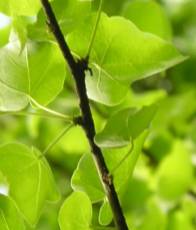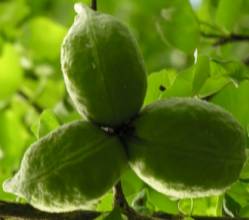Sterculia rogersii
Sterculia rogersii N.E.Br.
Family: Malvaceae
Common names: star-chestnut (Eng.); sterkastaiing (Afr.); mokgwakgwatha (NS); samani, nsolodza (Ts)
SA Tree No: 477
Introduction
This is a small tree with smooth bark flaking to reveal reddish to purple or yellowish under-bark and a characteristic thickset trunk. It has saucer-shaped, showy yellow flowers with radiating red streaks carried on the old wood and young branches, making it a very interesting garden subject.

Description
Description
This small squat thickset tree can grow up to 6 m high and is deciduous. The main trunk is thickset with smooth bark flaking and revealing reddish to purple or yellowish under-bark. The branchlets are grey and papery with a white warty appearance.


The yellowish-green leaves appear late in the season and fall early. They can either be alternate or can cluster on short side branches. They are broadly ovate (egg-shaped) to rounded. The tips of the leaves are broadly tapered, while the base is deeply cordate (heart-shaped). The margins of the leaves are slightly to deeply lobed with three to five lobes present. The margins are entire and the leaves are softly hairy.
The flowers usually appear before the leaves from about June to December in clusters on the bare branches. The flowers are yellow with radiating red streaks.


The star-shaped velvety fruit capsules start appearing from September and ripen towards March. Each fruit turns from green to a pale yellow. When ripe it splits open to release approximately 10 grey smooth seeds through a gap lined with golden hairs.
Conservation Status
Status
None.
Distribution and habitat
Distribution description
Sterculia rogersii can be found growing naturally in the lowveld of KwaZulu-Natal, Limpopo Province, as well as Swaziland, Botswana, Zimbabwe and Mozambique. It prefers low dry bushveld, usually in rocky river gorges or on dry rocky outcrops.
Derivation of name and historical aspects
History
The genus Sterculia comes from the Roman god of dung and manure, referring to the slightly pungent smell of the flowers. The species rogersii was named after Archdeacon F.A. Rogers, an English missionary and collector of over 24 000 plant specimens.
Ecology
Ecology
Birds, game and stock eat the seeds of this tree. The leaves and young stems are eaten by browsers.
Uses
Use
The bark of this tree is known to provide a good quality fiber. This fiber can then be used to weave fishing nets and as a thread for sowing articles such as sleeping mats. The seeds of the Star-chestnut are edible, but the hair surrounding the seeds irritates the skin. The dried pods are used by some as decorations on Christmas trees - either in their natural colour or painted.
Growing Sterculia rogersii
Grow
The size of the tree, its showy flowers and interesting shaped fruit as well as the fact that it grows easily from seed and cuttings makes for an interesting garden subject for small and medium sized frost-free gardens.
If grown from seed, the seeds should be soaked in hot water until they are slightly swollen. Plant the seeds in well drained soil. A 40:40:20 mix of garden soil, river sand and compost works well. Make sure the area chosen for planting is a hot dry spot. Watering requirements are medium, be cautious not to over water. Do not water during winter when the plant is dormant.
Sterculia rogersii can be used as a pot plant and can be made into a bonsai.
References
- Schmidt,Ernst., Lotter,Mervyn, McCleland. 2002. Trees and shrubs of Mpumalanga and Kruger National Park. Jacana. Johannesburg.
- Pooley, Elsa.1993. The complete field guide to Trees of Natal Zululand & Transkei. Natal Flora Publications Trust c/o Natal Herbarium.Durban
- Coates Palgrave, Meg. 2002. Keith Coates Palgrave Trees of Southern Africa. Struik Publishers. Cape Town.
- Little, R. John.1980.A Dictionary of Botany. Van Nostrand Reinhold Company Inc. New York.
- http://www.africantrees.com/details.asp?treeID=5
Credits
Lou-Nita Le Roux
Lowveld National Botanical Garden
March 2011
Plant Attributes:
Plant Type: Tree
SA Distribution: KwaZulu-Natal, Limpopo, Mpumalanga
Soil type: Sandy
Flowering season: Early Summer, Winter
PH: Neutral
Flower colour: Yellow
Aspect: Full Sun, Morning Sun (Semi Shade), Afternoon Sun (Semi Shade)
Gardening skill: Average
Special Features:
Horticultural zones








Rate this article
Article well written and informative
Rate this plant
Is this an interesting plant?
Login to add your Comment
Back to topNot registered yet? Click here to register.